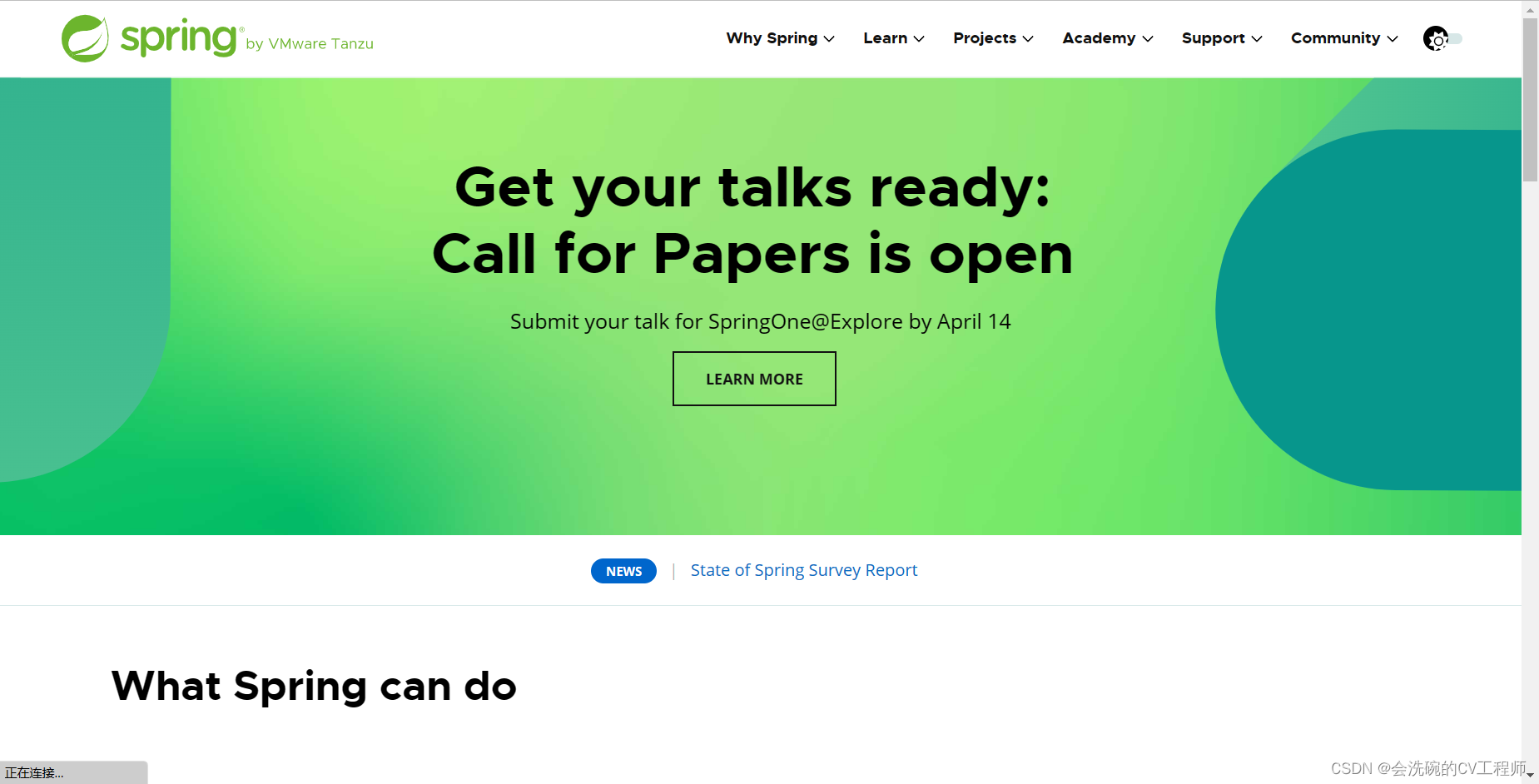Spring IOC 入门简介【自定义容器实例】

目录
前言
Spring简介
Spring体系结构
一、IOC控制反转思想
二、IOC自定义对象容器
1. 创建实体类,Dao接口,实现类
2. 创建配置文件bean.properties
3. 创建容器管理类
4. 创建StudentService类
5. 测试方法
6. 测试结果
前言
Spring简介
Spring是一个开源框架,为简化企业级开发而生。它以IOC(控制反转)和AOP(面向切面)为思想内核,提供了控制层SpringMVC、数据层SpringData、服务层事务管理等众多技术,并可以整合众多第三方框架。Spring将很多复杂的代码变得优雅简洁,有效的降低代码的耦合度,极大的方便项目的后期维护、升级和扩展。
Spring官网地址:https://spring.io/Spring官方网站:
Spring体系结构
Spring框架根据不同的功能被划分成了多个模块,这些模块可以满足一切企业级应用开发的需求,在开发过程中可以根据需求有选择性地使用所需要的模块。
- Core Container:Spring核心模块,任何功能的使用都离不开该模块,是其他模块建立的基础。
- Data Access/Integration:该模块提供了数据持久化的相应功能。
- Web:该模块提供了web开发的相应功能。
- AOP:提供了面向切面编程实现
- Aspects:提供与AspectJ框架的集成,该框架是一个面向切面编程框架。
- Instrumentation:提供了类工具的支持和类加载器的实现,可以在特定的应用服务器中使用。
- Messaging:为Spring框架集成一些基础的报文传送应用
- Test:提供与测试框架的集成
一、IOC控制反转思想
控制反转就是让框架创建对象
IOC(Inversion of Control) :程序将创建对象的权利交给框架。之前在开发过程中,对象实例的创建是由调用者管理的,代码如下:
public interface StudentDao {// 根据id查询学生Student findById(int id); }public class StudentDaoImpl implements StudentDao{@Overridepublic Student findById(int id) {// 模拟从数据库查找出学生return new Student(1,"程序员","北京");} }public class StudentService {public Student findStudentById(int id){// 此处就是调用者在创建对象StudentDao studentDao = newStudentDaoImpl();return studentDao.findById(1);} }这种写法有两个缺点:
- 浪费资源:StudentService调用方法时即会创建一个对象,如果不断调用方法则会创建大量StudentDao对象。
- 代码耦合度高:假设随着开发,我们创建了StudentDao另一个更加完善的实现类StudentDaoImpl2,如果在StudentService中想使用StudentDaoImpl2,则必须修改源码。
而IOC思想是将创建对象的权利交给框架,框架会帮助我们创建对象,分配对象的使用,控制权由程序代码转移到了框架中,控制权发生了反转,这就是Spring的IOC思想。而IOC思想可以完美的解决以上两个问题。
二、IOC自定义对象容器

接下来我们通过一段代码模拟IOC思想。创建一个集合容器,先将对象创建出来放到容器中,需要使用对象时,只需要从容器中获取对象即可,而不需要重新创建,此时容器就是对象的管理者。
1. 创建实体类,Dao接口,实现类
Student实体类
package com.example.pojo;public class Student {private int id;private String name;private String address;public Student(int id, String name, String address) {this.id = id;this.name = name;this.address = address;}public Student(){}public int getId() {return id;}public void setId(int id) {this.id = id;}public String getName() {return name;}public void setName(String name) {this.name = name;}public String getAddress() {return address;}public void setAddress(String address) {this.address = address;}@Overridepublic String toString() {return "Student[ " +"id=" + id +", name='" + name + '\\'' +", address='" + address + '\\'' +" ]";}
}
StudentDao接口
package com.example.dao;import com.example.pojo.Student;public interface StudentDao {// 根据id查询学生Student findById(int id);
}
StudentDao接口实现类1:StudentDaoImpl1
package com.example.dao;import com.example.pojo.Student;public class StudentDaoImpl1 implements StudentDao{public StudentDaoImpl1() {}public StudentDaoImpl1(int a){};@Overridepublic Student findById(int id){return new Student(id,"程序员","北京");}
}
StudentDao接口实现类1:StudentDaoImpl2
package com.example.dao;import com.example.pojo.Student;public class StudentDaoImpl2 implements StudentDao{@Overridepublic Student findById(int id) {// 模拟根据ID查询学生System.out.println("新方法!!!");return new Student(id,"程序员","上海");}
}
2. 创建配置文件bean.properties
该文件中定义管理的对象
studentDao=com.example.dao.StudentDaoImpl23. 创建容器管理类
package com.example;import java.io.InputStream;
import java.util.Enumeration;
import java.util.HashMap;
import java.util.Map;
import java.util.Properties;public class Container {static Map<String,Object> map = new HashMap<>();static {// 读取配置文件InputStream is = Container.class.getClassLoader().getResourceAsStream("bean.properties");Properties properties = new Properties();try{properties.load(is);}catch (Exception e){e.printStackTrace();}// 遍历配置文件的所有配置Enumeration<Object> keys = properties.keys();while(keys.hasMoreElements()){String key = keys.nextElement().toString();String value = properties.getProperty(key);try{Object o = Class.forName(value).newInstance();map.put(key,o);}catch (Exception e){e.printStackTrace();}}}// 从容器中获取对象public static Object getBean(String key){return map.get(key);}
}
4. 创建StudentService类
package com.example.service;import com.example.Container;
import com.example.dao.StudentDao;
import com.example.domain.Student;public class StudentService {public Student findStudentById(int id){// 从容器中获取对象StudentDao studentDao = (StudentDao) Container.getBean("studentDao");System.out.println(studentDao.hashCode());return studentDao.findById(id);}
}
5. 测试方法
package com.example.test;import com.example.Container;
import com.example.service.StudentService;public class Test {public static void main(String[] args) {StudentService studentService = new StudentService();System.out.println(studentService.findStudentById(1));System.out.println(studentService.findStudentById(1));}
}
6. 测试结果

StudentService从容器中每次拿到的都是同一个StudentDao对象,节约了资源。
如果想使用StudentDaoImpl2对象,只需要修改bean.properties的内容为:studentDao=com.itbaizhan.dao.StudentDaoImpl2即可,无需修改Java源码。
或者如果不想new StudentService,也可以在bean.properties加上一行:
studentService = com.example.service.StudentService


